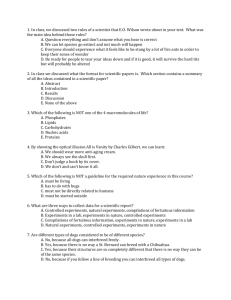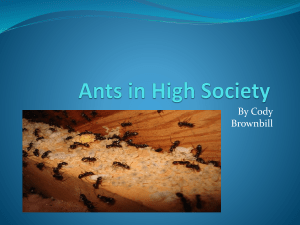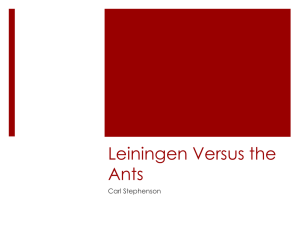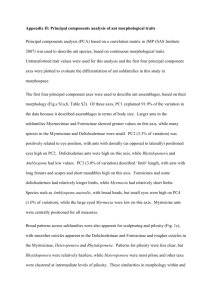DOCX - Northern Territory Government
advertisement
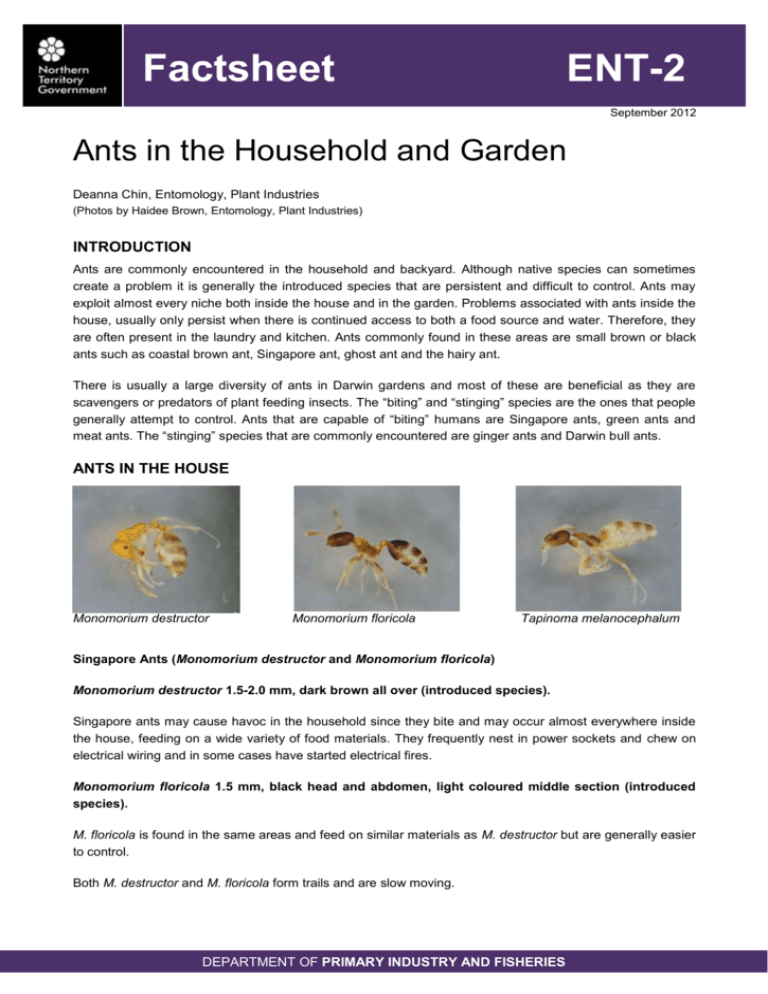
Factsheet ENT-2 September 2012 Ants in the Household and Garden Deanna Chin, Entomology, Plant Industries (Photos by Haidee Brown, Entomology, Plant Industries) INTRODUCTION Ants are commonly encountered in the household and backyard. Although native species can sometimes create a problem it is generally the introduced species that are persistent and difficult to control. Ants may exploit almost every niche both inside the house and in the garden. Problems associated with ants inside the house, usually only persist when there is continued access to both a food source and water. Therefore, they are often present in the laundry and kitchen. Ants commonly found in these areas are small brown or black ants such as coastal brown ant, Singapore ant, ghost ant and the hairy ant. There is usually a large diversity of ants in Darwin gardens and most of these are beneficial as they are scavengers or predators of plant feeding insects. The “biting” and “stinging” species are the ones that people generally attempt to control. Ants that are capable of “biting” humans are Singapore ants, green ants and meat ants. The “stinging” species that are commonly encountered are ginger ants and Darwin bull ants. ANTS IN THE HOUSE Monomorium destructor Monomorium floricola Tapinoma melanocephalum Singapore Ants (Monomorium destructor and Monomorium floricola) Monomorium destructor 1.5-2.0 mm, dark brown all over (introduced species). Singapore ants may cause havoc in the household since they bite and may occur almost everywhere inside the house, feeding on a wide variety of food materials. They frequently nest in power sockets and chew on electrical wiring and in some cases have started electrical fires. Monomorium floricola 1.5 mm, black head and abdomen, light coloured middle section (introduced species). M. floricola is found in the same areas and feed on similar materials as M. destructor but are generally easier to control. Both M. destructor and M. floricola form trails and are slow moving. DEPARTMENT OF PRIMARY INDUSTRY AND FISHERIES Ghost Ant (Tapinoma melanocephalum) 1.5-2.0 mm, black head and thorax, light brown abdomen (introduced species). These ants are fast moving and commonly found in trails on doors of cupboards and around the sink in kitchens and laundries. Damp or rotting particle board in the kitchen is often used as a nesting site. Ghost ants are attracted to all types of food but prefer products containing sugar. When crushed, the ants smell of rancid butter. ANTS IN THE GARDEN Paratrechina longicornis Solenopsis geminata Pheidole megacephala Hairy Ant (Paratrechina longicornis) 3.0 mm, dark brown to black in colour with fine hairs on body and legs (introduced species). This ant species is commonly found nesting in pot plants or hanging fern baskets. They are very fast moving and will disperse in all directions if disturbed. When searching for food (sugary foods preferred) they may form trails with large numbers of workers leading from pot plants on the verandah to a food source inside the house. Ginger Ant or Tropical Fire Ant (Solenopsis geminata) 2.4-6.0 mm, orange-brown in colour (introduced species). The ginger ant (also known as tropical fire ant), (Solenopsis geminata) is an introduced ant that is established in the Northern Territory. This species should not be confused with the red imported fire ant (Solenopsis invicta) which does not occur in the Northern Territory. These ants are 2.4-6.0 mm in length and are orange-brown or red-brown in colour. They build nests in open ground or under rocks. Sometimes a mound of loose dirt can be seen around the nest entrance. When disturbed these ants may bite and sting. The sting is usually painful and may produce an itchy sore. There are many ants that may be confused with ginger ants, some of these include; Tetramorium bicarinatum, Iridomyrmex pallidus, Monomorium spp. and Pheidole spp. These ‘other’ ant species may also be seen in the garden but they usually do not give a painful bite or sting. Ginger ants feed on grass seeds that they gather and store in their nests. Sometimes they chew on emerging seedlings and recently planted seeds as well as other live plant material. Ginger ants will also tend honeydew producing insects such as mealybugs, and feed on other insects and animal matter. These ants often nest in pot plants and may be transported to other properties. For further information on monitoring and control of ginger ants refer to Information Sheet No. 16 Monitoring and Control of Ginger Ants in Nurseries. © Northern Territory Government, 2010 Page 2 of 5 Coastal Brown Ant (Pheidole megacephala) workers 2.0-2.5mm, soldiers 3.5-4.5 mm. Shiny dark brown in colour. Soldiers with large heads (introduced species). This species has been observed to form very large colonies in houses and backyards in the Darwin area. They have a similar appearance to ginger ants. However, coastal brown ants have “soldiers” which have enlarged heads. In areas where they are present, they seem to out-compete other ant species due to their aggressive behaviour and large colonies. They may be seen in crevices in walls and floors both internally and externally, in cavity walls or nesting around rockeries and paths. If a property is infested with coastal brown ants, trails may be seen along the edge of garden beds or at the edge of lawns where sand may be excavated. The preferred foods are of animal origin, such as meat particles, dead insects, and products with a high fat content. Oecophylla smaragdina Iridomyrmex sanguineus Odontomachus turneri Green Tree Ant (Oecophylla smaragdina) 7.0-9.0 mm, yellow head and thorax with a green abdomen (native species). Green tree ants nest in shrubs and trees. In the absence of coastal brown ants they may occur in large colonies in Darwin gardens. They sometimes forage for pet food on verandahs by obtaining access from foliage growing against the house. These ants are often associated with scale insects and mealybugs as they tend them for honeydew. They are also predators as well as scavengers and feed on a range of insects and animal matter. Green tree ants are useful predators of other insects in the garden and should be left alone unless they are creating a problem. They live in nests made of leaves and may bite and spray formic acid if disturbed. If control is necessary, snipping off the nest in trees is generally the most effective method in reducing the numbers. Meat Ants (Iridomyrmex sanguineus (red) and Iridomyrmex reburrus (purple)) 5.0-8.0 mm; red, brown, orange or purple head and thorax. Green-black abdomen (native species). Meat ants nest in the soil and usually prefer bare ground and are more common in drier areas of the Northern Territory. These ants will feed on dead insects, lizards or any animal material in the garden. Meat ants attack intruders along their trails or near their nest. These ants emit a distinctive smell when crushed. Darwin Bull Ant (Odontomachus turneri) 7.0-10.0 mm, black all over (native species). The Darwin bull ant is one of the largest species in the Darwin area. They are predators of small invertebrates and capture prey with their large mandibles (tooth-like jaws). Stings from these ants can be very painful and may cause local swelling. These ants may be seen foraging on the ground or on low vegetation. Nests are usually in soil, mulch or rotten wood on the ground. © Northern Territory Government, 2010 Page 3 of 5 ANTS THAT "FARM" OTHER INSECTS Several other species of ants may be associated with “honeydew producing” insects such as scales, planthoppers or mealybugs which they “farm” by transferring them from old foliage to new foliage on the one plant or from one plant to another. Ants use honeydew as an alternate food source. This situation is commonly seen on ornamentals, native plants and fruit trees. MANAGING POPULATIONS This factsheet is not intended to outline methods for eradicating ants. Some of these species are native and the purpose of this factsheet is to outline suggested methods in reducing the population to a more manageable level. The mention of trade names does not imply endorsement of preference for any company’s product by the Department of Primary Industry, Fisheries and Mines. Trade names are only listed as examples of products and other trade names not listed may also be available. Ants may be beneficial by predating on some insect pests, and as scavengers, they are important in accelerating nutrient recycling. Chemical control should only be applied to species that are causing problems. Hygiene In most problem situations, the number of ants may be greatly reduced by removing their food source. Kitchen scraps should be collected and disposed of and benches wiped down with detergent after every meal. Outdoor species including green tree ants, ginger and meat ants are often attracted to pet food. If the pet food bowl is placed in a larger, shallow saucer of water, this will prevent the ants from gaining access to the food and the problem should be reduced. Baits Ant baits are prepared by incorporating a chemical into a food source known to be attractive to that particular species. Baiting is generally more effective than insecticide sprays as the bait is carried back to the nest by worker ants and the whole colony is destroyed. When treating large colonies, baiting may need to be repeated after two weeks. Always, ensure that baits are placed out of reach of children, pets or wildlife. It may be necessary to place baits in child proof or pet proof containers. Hairy Ant and Ghost Ant These ants are attracted to sugar and can be successfully treated with Ant-rid® (honey solution with boron present as disodium tetraborate decahydrate). Singapore Ants Monomorium may be more persistent and are usually difficult to control as they do not readily take up the honey solution baits. Ant baits containing the active constituent: fipronil housed in small plastic trays are effective against Monomorium. An example of this product is Combat Ant-Rid®. These baits are usually available from supermarkets, hardware stores or agricultural suppliers. Ginger Ant, Coastal Brown Ant and Bull Ant For control of ginger ant, coastal brown ant and bull ant, a granular bait containing the active constituent hydramethylnon such as Amdro® or Hymenopthor® or a granular product containing the active constituent chlorpyrifos (example: Antex Granules®) can be applied into the nest or along ant trails. These baits should not be used in vegetable gardens or food crops. Baits containing hydramethylnon, rapidly breaks down in sunlight. If the bait is sprinkled on the ground or in trails it is best applied in the late afternoon or evening. © Northern Territory Government, 2010 Page 4 of 5 Sprays Sprays are effective only when the ants come into contact with the chemical deposits. Household aerosol sprays containing pyrethrums are generally of low toxicity to humans and are effective as a fast knock-down contact spray for ants. More persistent sprays such as permethrin or propoxur may be used as a long-lasting surface spray to protect electrical equipment and to provide barriers against Monomorium spp. (Treatment of electrical wiring should be carried out by a licensed pest control operator or electrician.) If species such as ginger ants and meat ants are posing a problem by attacking humans or pets, try to locate the nest (in ground or soil) and apply a registered product such as permethrin (example: Coopex ®) to the entrance of the nest. The treatment may reduce the population but generally does not eradicate the colony. Grease or Adhesive Barriers Grease, petroleum jelly or a non-drying adhesive such as Tac-Gel ® may be applied to verandah posts or trees to form a barrier against green ants or other ants. If this technique is used on trees, the grease or adhesive should be applied on a metal strip, padded by cloth and circling the main trunk. The foliage of the treated tree should not touch nearby trees. Barriers need to be checked regularly as dust and leaves build up on the greased or adhesive strips and decrease their efficiency. Further enquiries on ants may be addressed to the Entomology, Diagnostics Services on email insectinfo.dor@nt.gov.au Please visit us on our website at www.primaryindustry.nt.gov.au Department of Primary Industry and Fisheries © Northern Territory Government Disclaimer: While all care has been taken to ensure that information contained in this Factsheet is true and correct at the time of publication, the Northern Territory of Australia gives no warranty or assurance, and makes no representation as to the accuracy of any information or advice contained in this publication, or that it is suitable for your intended use. No serious, business or investment decisions should be made in reliance on this information without obtaining independent/or professional advice in relation to your particular situation. © Northern Territory Government, 2010 Page 5 of 5

